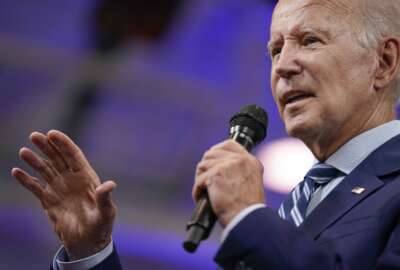
Pay agent calls for ‘major reforms’ to federal pay system, approves four new pay localities
The President’s Pay Agent issued an annual report, approving four new pay localities, while also noting the need for larger reforms to the federal compensation...
Leaders in the Biden administration called for “major reforms” to the federal pay system, building on a not-so-new conversation around issues with the compensation system for much of the federal workforce.
The current structure for determining pay for the 1.5 million federal employees on the General Schedule is inherently flawed, the President’s Pay Agent said in its annual report to the president.
“As has been noted in earlier pay agent reports and discussed in other venues, we believe there is a need to consider major legislative reforms of the white-collar federal pay system, which continues to utilize a process requiring a single percentage adjustment in the pay of all white-collar civilian federal employees in each locality pay area without regard to the differing labor markets for major occupational groups,” the pay agent said in the Dec. 19 report. “The current pay comparison methodology used in the locality pay program ignores the fact that non-federal pay in a local labor market may be very different between different occupational groups. As currently applied, locality payments in a local labor market may leave some mission-critical occupations significantly underpaid while overpaying others.”
The pay agent, composed of Office of Personnel Management Director Kiran Ahuja, Labor Secretary Marty Walsh and Office of Management and Budget Director Shalanda Young, issued its annual report ahead of the planned 4.6% pay raise for the federal workforce in 2023.
At the same time that it called for larger reforms, the pay agent also responded to seven recommendations from the Federal Salary Council, agreeing with many of the council’s recommendations from earlier this year.
Most notably, the pay agent approved the council’s recommendations to add four new pay localities:
- Fresno, California
- Reno, Nevada
- Rochester, New York
- Spokane, Washington
Additionally, the pay agent agreed with the council’s recommendations to add the following areas to of already-existing pay localities:
- Emporia, Virginia, and Greensville County, Virginia, to the Richmond, Virginia, locality
- Dukes and Nantucket counties in Massachusetts to the Boston locality
- Huron County, Michigan, to the Detroit locality
- Pacific and San Juan counties in Washington to the Seattle locality
In total, an estimated 32,000 GS employees would be moved to a higher-paying locality area based on the report. But the earliest that any changes to locality pay area boundaries could go into effect, according to the pay agent, would be January 2024. That’s because the Office of Personnel Management first has to issue regulations before the changes can take place.
The pay agent approved another council recommendation to add 10 new locations added as “research areas,” to estimate federal salaries in areas with fewer than 2,500 GS employees, and to potentially be considered as future pay localities. The council recommended the following 10 places as research areas:
- Asheville, North Carolina
- Brownsville, Texas
- Dothan, Alabama
- Kalamazoo, Michigan
- Lincoln, Nebraska
- Parkersburg, West Virginia
- Reno, Nevada
- Rochester, New York
- Scranton, Pennsylvania
- Shreveport, Louisiana
Two of those areas — Reno, Nevada and Rochester, New York — have been tentatively approved as new pay localities, but will remain research areas until the pay agent publishes regulations for all four of the new localities. The pay agent added that the council should continue working with the Bureau of Labor Statistics to determine if salary estimates can be provided for additional locations that have fewer than 2,500 GS employees.
OPM also recently added two more surrounding areas to existing pay localities:
- Carroll County, Illinois, to the Davenport-Moline, Iowa-Illinois, locality
- Brooks County, Texas, to the Corpus Christi-Kingsville-Alice, Texas, locality
But again, none of the potential changes to locality pay areas would go into effect until at least 2024.
In the report, the pay agent also noted that there’s a growing disparity between federal and non-federal pay rates across the country. Most recently, the Federal Salary Council reported that in 2022, federal workers earned 24.09% less in wages alone than non-federal colleagues — a larger gap than the 22.47% reported in 2021.
The debate around federal-private pay disparity is far from new. The Federal Employees Pay Comparability Act of 1990 aimed to eliminate the growing gap between federal and non-federal salaries, by authorizing the full pay raise necessary to reduce the pay gap down to a 5% disparity. But since 1994, no administration has fully adopted the pay adjustments that the legislation allows.
At this point, the estimated cost to reduce the pay disparities down to 5% is approximately $19.2 billion — and that cost is a “significant consideration,” the pay agent said.
“However, it is also important to emphasize that the underlying methodology for locality pay of relying on one singular locality rate covering a locality pay area has lacked credibility since the beginning of locality pay in 1994 to such a degree that the statutory formula for closing pay gaps has been overridden either by Congress or by successive presidents each and every year since that first year,” the pay agent added.
The government calculates the pay disparity by comparing the base pay for federal employees on the General Schedule with that of non-federal employees working in the same geographic area.
Some disagree that federal pay falls behind that of the private sector, though. The council calculates the disparity based on wages alone and doesn’t account for the value of benefits. When taking that into account, some groups, including the Congressional Budget Office, have said that federal employees are technically overpaid.
But many federal advocacy groups have called for major reforms or even a full replacement of the system. The Trump administration similarly advocated for a revision to the system back in the 2020 report from the President’s Pay Agent.
The pay agent’s 2022 report is the first time that the group has responded to council recommendations under the Biden administration. This time last year, Biden hadn’t yet nominated new political appointees to serve on the Federal Salary Council.
Copyright © 2024 Federal News Network. All rights reserved. This website is not intended for users located within the European Economic Area.
Drew Friedman is a workforce, pay and benefits reporter for Federal News Network.
Follow @dfriedmanWFED





